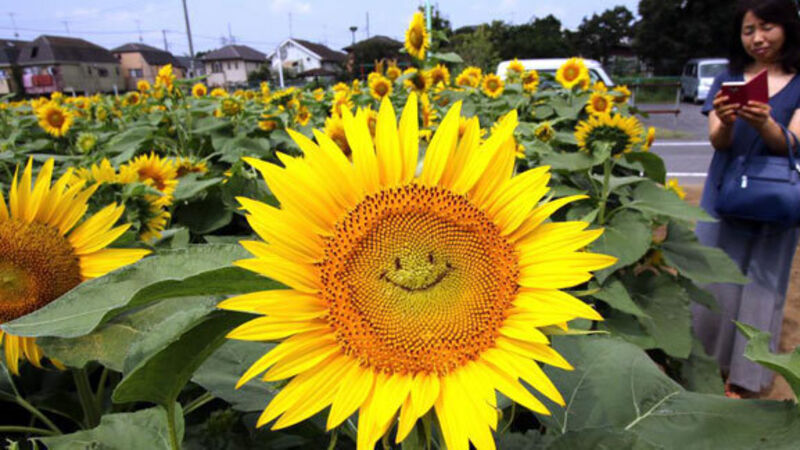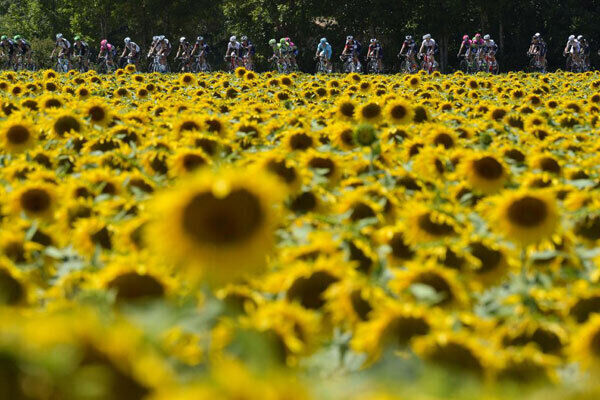Celebrate the sunflower in its many wonderful forms and colours

It’s an extremely large family of plants comprising more than 1,600 genera with more than 26,500 species.
The flowers are nearly all composite in form and often surrounded by involucral bracts.
But why would you want to make something as simple and as pleasurable as growing flowers sound so dull and uninteresting?
Unless you’re studying horticulture there really is no need to know all that and in those terms.
What about if I started talking about Sunflowers, already you’re smiling for who can’t think of the lovely bright yellow and orange blooms of sunflowers without smiling.
They grow before your eyes into the most magnificent of summer flowering beauties, bringing a stately but fun presence into any garden.
This year I was growing them from seed with children and their delight each week when they went out to see their progress was palpable.
Well, sunflowers or Helianthus are members of the Asteraceae family. It may surprise you to learn that not all sunflowers are yellow, in fact far from it.
Every colour from yellow and orange through to pink, red and even chocolate brown are found on different sunflower seedlings.

Sunflowers play an important economic role in some countries as the seeds and oils are an important commodity and offer many health benefits providing us with fibre, the good fats which help to reduce cholesterol, many vitamins and also some of our minerals, such as iron and zinc.
I have about 10 or 12 of them in my garden this year and while the last of the blooms is now faded there is something special about watching the seed heads ripen as we head into harvest season.
I’ll keep some seed of course for next year but also I’ll harvest them to eat, without being so greedy as to leave none for the birds.
But it is the Sunflower’s first cousin, Helenium, also a member of the Asteraceae family that is stealing the show at the moment and in truth it has been at its best now for well over six weeks.
It’s the variety ‘Sahin’s Early’ that I am referring to, with its burnt orange and yellow blooms which reflex back from the dark brown, nearly black centre which is so loved by the bees and butterflies.
It grows to about 1.5 metres in height and the clump I have which I planted nearly four years ago, is now beginning to outgrow its space so I will lift it this winter and divide into as many as 12 new plants which is great because I have a fence painted a creamy white colour which needs something planted at its base and so from next spring it will have a dozen ‘Sahin’s Early’ growing from beneath, which will certainly give me the display I am seeking.
I need to plant something evergreen with it though, as the Heleniums, depending on their species are all annual, biennial or herbaceous perennials.
‘Sahin’s Early’ will come on every year getting bigger each season, but it is herbaceous so my fence will be bare during the winter months unless I find a suitable dance partner for it.
I am thinking either Stipa ‘Ponytails’ which will offer not only the lovely airy grassy texture which makes it an ideal plant to combine with nearly anything, but also a lovely winter display with lovely oaty coloured seed heads which offer a beneficial food source to finches and other small birds.
The other plant I am thinking about planting with it is Erysimum ‘Variegatum’ or the Variegated Perennial Wallflower.
A plant which offers value for 52 weeks of the year and foliage that is so bright and cheerful, it will contrast nicely with the dark orange of the Helenium. And it produces masses of mauve/pink flowers throughout the year.
If I am to give the Erysimum the text book treatment I will say that it produces these flowers from mid spring through to early autumn and should be cut back after flowering.
However if you wait until after flowering before you cut it back, then you will never have an opportunity to prune it as it never seems to be bereft of blooms. But do cut it back in September and maybe again in mid-March or else it will surely get too woody and lanky.
Maybe I will plant all three by the base of the fence as then I will have a combination that offers colour all year round with lovely texture contrasts and plenty of seasonal interest.
The Jerusalem Artichoke, Helianthus tuberosus, Echinacaea, many of what we call daisies and Chrysanthemums are all members of the Asteraceae family as if of course, as the name suggests the aster.
I love the bedding asters offering a late shot of colour to the summer displays, I love the forma and vivid colour of the flowers. They are much more showy than their perennial counterparts, of which there are many different species. But do hold out for Aster firkartii Monch.
Its blooms are smaller than the bedding types but produced en masse, and give a great pale purple display from now right into the winter.
Indeed many of the different Asters will give just as good a display of floral colour but where ‘Monch’ outshines all the rest is its resistance to mildew and many of the fungal rusts which so much damage the other species.
It will grow to about a metre in height and with its untidy and informal growth habit it will cover an area about a metre in width. Another must-have plant for the next few months in the garden.









